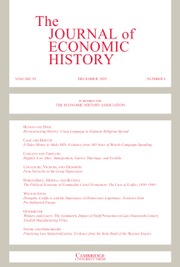No CrossRef data available.
Article contents
Firm Networks in the Great Depression
Published online by Cambridge University Press: 23 September 2025
Abstract
We study how firms allocate resources across their constituent establishments in response to local economic shocks in the context of the Great Depression. Using establishment-level data from the Census of Manufactures, we find that establishments in multi-plant firms are affected by local shocks in the regions in which the other establishments comprising the firm are located. In particular, establishment employment is positively affected by positive shocks to the local supply of credit to other establishments that make up the firm. Our results show the important role of firms in the geographic propagation of local economic shocks.
Information
- Type
- Article
- Information
- Copyright
- © The Author(s), 2025. Published by Cambridge University Press on behalf of Economic History Association
Footnotes
Joe Ferrie, Xavier Giroud, David Mauer, Joel Mokyr, Jonathan Parker, and Alex Poirier provided valuable feedback at the early stages of the project. We also thank anonymous referees at JEH and the editor Eric Hilt for a number of excellent suggestions. The data collection effort was funded by National Science Foundation grants SES 1122509 and 1459263, as well as the Graduate School and the Center for the Study of Industrial Organization at Northwestern University. We received useful comments from participants at the Macro Lunch at Northwestern University as well as seminars at Notre Dame, Maryland, Arizona, Iowa Finance, Clemson, Northwestern, UCLA, Miami University, the Bureau of Economic Analysis, NBER DAE Spring Program Meetings, All-UC “100 Years of the Fed” Conference, AEA 2019 Annual Meeting, Duke-UNC Finance Conference, and NBER Macro Time and Space Conference. NLZ thanks the Robert Eisner Memorial Fellowship and the Sokoloff Fellowship for providing support.

